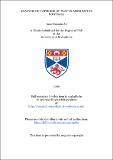Files in this item
Analysis of patterns of play in association football
Item metadata
| dc.contributor.advisor | Farrally, Martin R. | |
| dc.contributor.author | Ali, Araz H. | |
| dc.coverage.spatial | 477 p. | en_US |
| dc.date.accessioned | 2018-07-12T08:38:25Z | |
| dc.date.available | 2018-07-12T08:38:25Z | |
| dc.date.issued | 1990 | |
| dc.identifier.uri | https://hdl.handle.net/10023/15283 | |
| dc.description.abstract | The main problem in analysing soccer is the existence of a large number of interacting variables. Far fewer difficulties exist for cricket, baseball, racket ball games or even American football, where the actions may be broken down into a series of discrete events which are relatively easy to record and assess. Despite the considerable interest which soccer matches provoke, and the many varied post-game discussions on its strategy which often result, little research has actually been conducted into the strategical aspect of play. This study is an attempt to examine patterns of play at professional level and more specifically, to investigate whether successful attacking patterns can be identified which are commonly used by all teams. The study concentrates on the analysis of patterns of play in soccer, by examining the suitability and accuracy of the two methods of obtaining objective data on patterns of play; the live match analysis technique and the video recording technique with subsequent analysis. The results show that both techniques produce the same results; however, the former is more convenient. Data for five league teams playing home and away matches and for an international team playing five home matches during the season 1987-1988 have been obtained and analysed. Analysis of patterns of play for the five league teams shows that there were similarities and dissimilarities between the top and the poorer teams. The distinct patterns of play identified for each team in both home and away matches were few in number. Top teams had the same number of successful patterns of play in home and away matches. The poorer teams also had the same number of successful patterns in home and away matches but they were fewer In number. Top teams applied the same strategies when they played at home or away whilst the poorer teams applied different strategies when playing at home or away. These findings led to another investigation which compared the patterns of play of the league teams with those of an international team. The international team and the poorer league teams had the same number of successful patterns of play in home matches but they were fewer in number than those of the top league teams. Successful patterns of play appeared more often for the international and league teams in those matches they won. The number of free attacking moves and set pieces in a match did not give any indication of success for the international and league teams. A team wins when it has a greater number of shots on target and a greater proportion of attacks producing shots regardless of whether the team is playing at league or international level. The final part of the study examines the defensive strategies employed against the successful attacking patterns of play of the five league teams. The results indicate that both the top teams and the poorer teams had distinct successful defensive strategies which were similar in home and away matches but the defensive strategies of the poorer teams were, of course, less successful than those of the top teams. These findings clearly indicate that there are similarities in employing defensive strategies in home and away matches for all teams, but the defensive strategies of the top and the poorer teams were markedly dissimilar. It is clear that close marking is a crucial element of the best defensive strategies (i.e. teams who marked their opponent players most frequently, succeeded in nullifying successful attacking patterns of play). | en_US |
| dc.language.iso | en | en_US |
| dc.publisher | University of St Andrews | en_US |
| dc.subject.lcc | GV943.9A6 | |
| dc.subject.lcsh | Soccer--Coaching | en |
| dc.title | Analysis of patterns of play in association football | en_US |
| dc.type | Thesis | en_US |
| dc.type.qualificationlevel | Doctoral | en_US |
| dc.type.qualificationname | PhD Doctor of Philosophy | en_US |
| dc.publisher.institution | The University of St Andrews | en_US |
This item appears in the following Collection(s)
Items in the St Andrews Research Repository are protected by copyright, with all rights reserved, unless otherwise indicated.

